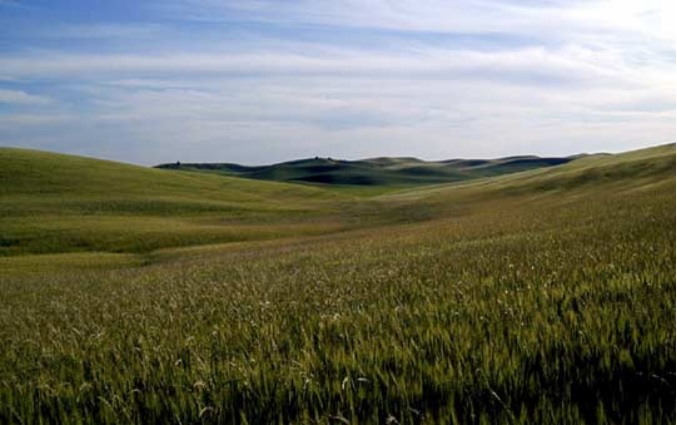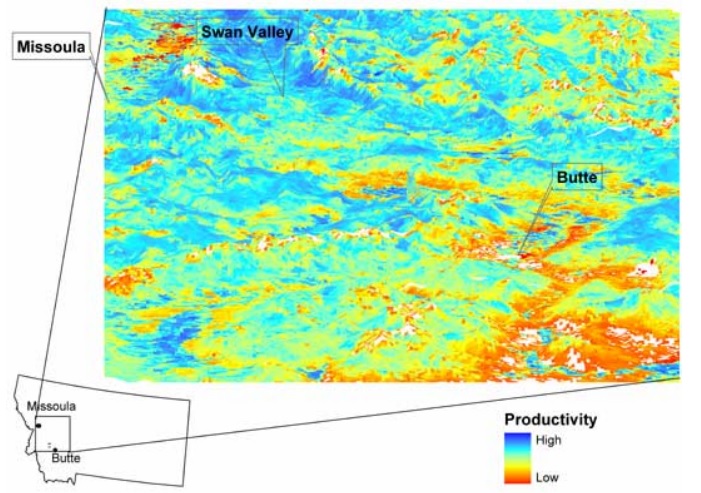In the Northern Great Plains, open prairies extend, unbroken, to the horizon. Amid the rolling hills and endless skies, proximity is an illusion. A team of researchers, making their way through the 800,000 hectares (2 million acres) of the Little Missouri National Grassland of North Dakota, spent countless hours clipping, separating, drying, and weighing various plains grasses during the spring and summer seasons of 2001 and 2002. The goal of this tedious undertaking was to test a new way to manage enormous pieces of land like the National Grasslands. The researchers used these ground observations to corroborate data received from a satellite sensor.
One of the investigators, Matthew Reeves of the LANDFIRE Program at the Rocky Mountain Research Station Fire Sciences Laboratory in Missoula, Montana, focused his PhD research on management applications derived from satellite technology. "There's a large interest and a big push, nowadays, to get satellite technology distilled into a format that a more general audience can use for answering strategic questions." Reeves aims to wrap this high-end technology into a comprehensible data package that land managers can apply to overseeing rangelands.
Knowing how the land is responding to pressures is key to maintaining its health and longevity. For example, if cattle herds eat all of the vegetation, the rangeland, which supplies important habitat for many species of plants and animals, will be depleted and the animals living there will eventually go hungry. In such a case, land managers seek to move the cattle before the land becomes barren; restoring it to a fertile state can take decades. Researchers have turned to Moderate Resolution Imaging Spectroradiometer (MODIS) satellite data, archived at NASA's Land Processes Distributed Active Archive Center (LP DAAC), in hopes that it will provide large-scale land managers with a tool to help them keep the plains healthy and robust.
Soon, it may be possible for land managers to keep watch over remote acreage with the click of a mouse. From the vantage of an office, decision makers could open up a satellite image on a computer screen and find out that an isolated pasture shows signs of greening up or dying off. Analyzing the health of large landscapes can help gauge the human impact on an area and the demand for resources. By monitoring fluctuations in the vitality of rangelands, decision makers can design cohesive management strategies and modify grazing pressures accordingly. For the Bureau of Land Management and other agencies that are responsible for monitoring huge districts, using satellites to supervise large tracts of land alleviates demand for operating money and employee time.
Predicting productivity
Using a new data processing scheme, which includes MODIS satellite data and meteorological inputs, Reeves intends to predict potential future conditions instead of simply interpreting current conditions. Knowing the types of weather events that a land area endures enables investigators to forecast how vegetation will respond. Without the supplementary meteorological data, Reeves could only look at the satellite imagery and determine whether or not the land cover was green and healthy on the day the image was captured. He could not predict its vigor two weeks into the future by looking at surface reflectance data from MODIS alone.
Researchers can now apply a specific mathematical equation, known as the MOD17 algorithm, to deduce a Group (NTSG) at the University of Montana, said, "It's meant to be a simplified carbon balance for a terrestrial ecosystem, where you are using the satellite to quantify the vegetation cover and light absorption." The carbon balance accounts for the carbon dioxide that plants absorb from the atmosphere and use for respiration. Through the process of photosynthesis, plants transform carbon into sugar, which feeds them and helps them grow. Researchers can determine the amount of sunlight and rainfall an area receives to predict vegetation growth. Applied to what is known about the life cycle of different plant species, information from MOD17 presents managers with the capability to forecast the health of a landscape.
Because the MOD17 equation uses both the MODIS satellite data and separate meteorology data from the Global Modeling and Assimilation Office (GMAO) at NASA's Goddard Space Flight Center, the algorithm has unprecedented applications. GMAO data include air temperature measurements, which can indicate that vegetation's photosynthetic activity has ceased because of below-freezing temperatures. The data also include vapor pressure measurements, essentially the amount of pressure that water molecules exert within a given volume of air. The combination of temperature and vapor pressure provide key information on humidity and water balance. Water balance provides a comparison of the amount of water supplied by precipitation, released into the atmosphere through evaporation and respiration, and stored within the soil.
Farming applications
To monitor vegetation vitality, investigators typically use a direct measure of the amount of solar energy absorbed by a plant's leaves. Researchers derive this measure from a remote sensing product called the normalized difference vegetation index (NDVI), which can indicate when the vegetation cover is dying or when the ground appears greenest, for instance. Using these measurements to construct a crop prediction model is practical only when on-the-ground conditions, such as season and region, are the same as the conditions assumed in the model. Land-cover researchers can now use the weekly vegetation measurements of MOD17 to avoid having to go back and formulate relationships between remote sensing data and observed vegetation.
Many crops, such as wheat, are sensitive to meteorological conditions that NDVI computations do not include, especially at crucial stages in the growth cycle. NDVI may indicate a significant amount of above-ground plant material, but it may not always be an accurate measure. For example, if a wheat crop suffers a drought during flowering, the crop yield could be lower than expected because the lack of water reduces a plant's fertility. NDVI, by itself, only allows for analysis of crop yield after the harvest has already taken place. Offering an eight-day, global composite data product, along with meteorological data, gives the MOD17 algorithm an advantage over the traditional NDVI method.
Accurate information about crop progress and production is essential to government planners in establishing market prices and preparing for emergency food reserves. The techniques also have the capability to provide statewide crop yield predictions, information that can prepare a state for the economic setbacks caused by drought. When Reeves applied the MOD17 equation to the readily available MODIS photosynthesis data, he was able to make accurate statewide wheat yield predictions in Montana.
The future of MOD17
Reeves hopes to extend his PhD research to the operations and maintenance side of the LANDFIRE program at Rocky Mountain Research Station, which is aimed at assessing fire potential and supporting landscape fire management planning. "I am planning to once again go to the MODIS data set, take advantage of its fantastic temporal resolution, and use it to update LANDFIRE fuel products," Reeves said. Using this type of technology to quantify the material that fuels wild fires presents another example of the extensive applications for MODIS.
After many tiresome days of working in the hot and humid fields of the Little Missouri National Grassland, cutting and sorting plant clippings, Reeves is confident in the satellite technology he toiled to validate with ground-based data. "MODIS is the most professional suite of products ever produced at this level," Reeves said. In the bright future of MOD17, a single land manager will be capable of monitoring mile upon mile of these rural tracts more efficiently than a handful of overseers could previously.
The next big step in the research is to give this technology a try. Running hopes to have a small group in Idaho test the package for actual application. He thinks managers will save time and money through the use of MODIS technology. "If a range manager can pop online to view a satellite image while in their office and find out that fifty miles away, a high-elevation pasture is now greened up and ready for grazing," Running said, "that may be the only way to get that information--other than by driving fifty miles up some dirt road and taking a look in person."
References
MOD17 Vegetation Production, NPP MOD16 Evapotranspiration and Surface Resistance, Land Science Team. Steve Running. Accessed July 12, 2006.
MODIS Land Team Net Photosynthesis and NPP. Steve Running. Accessed July 12, 2006.
Quantifying Herbaceous Biomass in a Rangeland Ecosystem Using MODIS Land Products. Matt Reeves. Accessed March 17, 2006.
Reeves, M. C., J. C. Winslow, and S. W. Running. 2001. Mapping weekly rangeland vegetation productivity using MODIS algorithms. Journal of Range Management 54: A90-A105.
Reeves, M. C., M. Zhao, and S. W. Running. 2005. Applying improved estimates of MODIS productivity to characterize grassland vegetation dynamics. Accepted for publication in the Journal of Rangeland Ecology and Management.
Reeves, M. C., M. Zhao, and S.W. Running. 2005. Usefulness and limits of MODIS GPP estimates for predicting wheat yield. International Journal of Remote Sensing 26(7): 1403-1421.
Running, S., R. Nemani, F. Heinsch, M. Zhao, M. Reeves, and H. Hashimoto. 2004. A continuous satellitederived measure of global terrestrial primary production. BioScience 54(6): 547-560.
For more information
NASA Land Processes Distributed Active Archive Center (LP DAAC)
Numerical Terradynamics Simulation Group at University of Montana
| About the remote sensing data used | ||
|---|---|---|
| Satellite | Terra/Aqua | |
| Sensor | Moderate Resolution Imaging Spectroradiometer (MODIS) | |
| Data set | MOD13Q1 | |
| Resolution | 250 meters | |
| Tile size | Regional | |
| Parameter | Biomass | |
| DAAC | NASA Land Processes Distributed Active Archive Center (LP DAAC) | |


